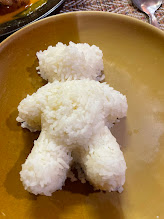MUAY THAI AND TRINKETS AND FOOD |
Teddy Bear sticky rice
at Kao Kab Kang |
After the bustle of Bangkok
and the frenetic revelry of Phuket and the other countless islands of Thailand,
(think of the show White Lotus), Chiang Mai is a popular tourist
destination. Last year 3.5 million visitors descended on Chiang Mai for her more
than 100 temples, her ecotourism, her food, her nightlife and her shopping.
According to Airbnb statistics, the average stay in Chiang Mai is 5.5 days. We stayed
at the Amora Tapae Hotel for three nights, using it mostly as a home base for
day trips in the area. We crammed a lot of activities in a short time and yet
felt like we missed so much.
AMORA THAPAE HOTEL CHIANG MAI
IN OAT WE TRUST
Overseas Adventure
Travels (OAT) a small group touring company took us to Chiang Mai as part of
their “Discover Thailand” excursion. The company arranged so many different
side trips while we were in Chiang Mai that we didn’t really have time to
wander the streets of Old City, the central tourist area of Chiang Mai.
 |
Tourists and pigeons at the Tha Phae Gate
Chiang Mai |
We didn’t get to visit
the lively Tha Phae Sunday night walking street market in the old city that
starts at the Tha Phae Gate and runs for about a kilometer, but that was
because we weren’t in Chiang Mai on a Sunday night. We also weren’t there for
any of the festivals that are held on the grounds of the Tha Phae Gate, well
because there were none scheduled during our time in Chiang Mai.We were so busy that we
did not get to window-shop, or sip coffee, or hit any of the nighttime spots
along trendy Nimmanhaemin Road.
 |
| Tha Phae Gate Chiang Mai |
We did walk through the
Tha Phae Gate while on a quick orientation walk when we first arrived in Chiang
Mai. The pavilion before the gate is a gathering place for people. Some, presumably
tourists, wore rented period costumes and posed for pictures. Photographers snapped
pictures of the tourists as an assistant would scatter the many pigeons lured
to the pavilion by seeds so they could snap a dramatic shot of the sky rats
fluttering by in the picture.
Apart from that short
orientation walk led by our trip leader through the gate and down Rachadamnoen
Street where the Sunday market is held and to briefly visit the Buddhist temple
Wat Phantao on Phra Pokklao Road that was it for us in the “old city.”
We had many
opportunities to go our own way while in Chiang Mai. One can always opt out of
what OAT has planned for a particular day. One planned trip even cost extra and
involved hiking through a national forest. We went on it and it consumed much
of the day. It’s always nice to have the option, but it did leave little wiggle
room for leisurely exploration.
 |
A Baht Bus Chiang Mai
(with old city moat in background) |
WHAT DID WE SEE
IN CHIANG MAI?
Chiang Mai Night Bazaar
The Chiang Mai Night
Bazaar was mentioned several times by our trip leader while we drove to the
city. He even tried to teach us a Thai phrase to barter, though every vendor we
met at the lively Night Bazaar and all the vendor lining the surrounding
streets spoke English and all were ready to barter and didn’t need to be
cajoled with a Thai phrase.
In case you’re wondering:
Lot Noi Dai Mai is what he wrote on a sheet of paper and hung at the front of the bus, which means "I have a lot." Lost in
Translation?
 |
| huh? |
You Can Get There From
Here
The Night Bazaar is
open every night and is one of the most popular tourist attractions in Chiang
Mai. For those who wanted to go our trip leader arranged for us to pile into a Songthaew,
or Baht Bus. This mode of transportation is everywhere in Thailand. Songthaew
are red ride-share pick-up trucks with twin benches in the back. Chaing Mai locals don’t call them Songthaew but
“rot si daeng”, literally red truck, or Baht bus.
 |
| Chiang Mai Night Bazaar |
To get somewhere on whatever
you want to call it, ask the driver if he’s going to your destination. He’ll
either squeeze you in with others, which means many stops and pick-ups. Or, if
there’s a lot of you and you can fill the Baht bus for 30 Baht each or 40 if you’re
feeling generous, you get to your destination cheaply. Much cheaper than a
taxi. A Songthaew is sort of like a mass transit version of a Tuk Tuk. There
are plenty of them throughout Chiang Mai and around the Night Bazaar there are
plenty of them circling. |
| Night Bazaar |
Trinkets
We went to the Night Bazaar
twice; our first night after an OAT supplied dinner at a local restaurant, and our
third and final night in Chiang Mai. The area of the Night Bazaar is sprawling. There’s
a big open area pavilion with a stage with live music and food stalls offering
everything from fish, meat, mango and sticky rice, and deep-fried insects. There
are lots of tables to eat your selected meal.
Inside the pavilion and
lining the streets in every direction are souvenir vendors selling everything
from football (soccer) kits, t-shirts (some emblazoned with remarkably bawdy
things like “I LOVE LADYBOYS”, art, cds, artifacts and elephants fashioned from
materials like wood and jade, and someone was making Tuk Tuks out of beer cans.
There were tailors willing to make you a suit, a shirt and dresses. We saw one
such tailor displaying a “fuck you” suit in their front window.
 |
how to influence
people |
All the vendors spoke
English and were willing to barter.
The Night Bazaar was originally
owned by Chinese merchants, whose influence can be seen at an ornate temple in
a nearby parking lot. The bazaar has grown in size and in popularity and truly
is worth a couple of Bahts to see it and to buy trinkets. We saw a lot of
westerners at the Night Bazaar. We found an open-air bar off to the side of the
stage and settled in for a drink and watched everyone from everywhere mingle in
the bazaar.
 |
Chinese parking lot temple
Chiang Mai |
Muay Thai
The first night we went
to specifically see Muay Thai boxing. We were fortunate that there was a fight
night slated when we arrived in Chiang Mai. Inside one section of the pavilion
a small arena was carved out and we got ringside seats to this extremely
vicious form of martial art. Admission for ringside was 1,000 Baht, but there
were other seatings for just 300 baht. We saw some great bouts and some
mediocre ones, but our trip leader arranged for us to get into the ring before
one bout to pose for pictures with a couple of fighters. I towered over them,
but I knew they could easily kick my butt, so I kept my mouth shut.
There were a lot of tattoos on each fighter, and a lot more flying kicks to the head. Fight nights like ours
in Chiang Mai are not rare at all, and you can often find a bout somewhere wherever
you are in Thailand. Later in our trip while
in Pa Tong on Phuket there were trucks roaming the streets advertising the
upcoming fight night matches.
Muay Thai for beginners
For those hearty and
hale and perhaps silly enough to explore the world of Muay Thai there are a several
gyms in every metropolitan area catering to such fool-hearty whims. Dang! Muay
Thai is in the Old City, offering lessons from absolute beginner to seasoned
fighter.
DANG MUAY THAI CHIANG MAI
What Is the “Old City”
In case you’re
wondering. Chiang Mai translates to “New City,” though it was founded in the
1200s. The city was the capital of the Lanna Kingdom from the 13th
to the 18th Century. “Old City” is a half-mile square section of Chiang
Mai that is enclosed by a moat with the remnants of the protective ancient
walls. It is a walking destination and there are little streets to explore and food vendors everywhere and countless massage parlors to choose from for a blissful hour. Just don't try getting a "That massage!"
Our hotel was the Amora
Phae, which is right off the moat and a short distance away from the Tai Phae
Gate, one of five entrances to the old kingdom.
WHAT’S FOR DINNER?
Influenced by its
proximity to Myanmar (Burma), Laos and China, Northern Thai cuisine differs from
the rest of the country with a blending of the styles. Expect to see noodle
dishes influenced by China or Larb, a traditional meat salad from Laos. Restaurants
back home rarely feature northern Thai cuisine. It’s less spicy than the south and
coconut milk is rarely used. It is an earthier, more rustic style of cooking.
Here are some
selections off the menu:
Khao Soi, a noodle dish with coconut
curry broth with a choice of chicken or meat.
Naem Moo, fermented pork
sausage.
Larb Khua Moo, ground pork and
lemongrass and spices.
Laphet Thoke, tea leaf salad
Of course you can never
go wrong eating street food, but we did eat at two restaurants while in Chiang
Mai and another with a family, as part of the OAT tour.
 |
| appetizer and Kao Kab Kang |
Kao Kab Kang 164, 110 Changklan Rd.
OAT brought us here as
part of our tour. Great atmosphere, friendly staff, and sticky rice shaped like
a teddy bear!
KAO KAB KANG, CHIANG MAI
The Swan Burmese Restaurant 48 Chaiyapoom Rd.
Just steps away from
our hotel, we ate here on our last night in Chiang Mai. Meat dishes available but
also vegan friendly. Nicely decorated, friendly staff.
THE SWAN BURMESE RESTAURANT, CHIANG MAI
Home hosted Dinner
 |
rice paddies of the
family who hosted |
As part of the OAT tour
experience, our trip broke us up in smaller groups and arranged for four of us
to dine with a farmer and his family as part of OAT’s Day in the Life program.
We ate at their house, surrounded by rice paddies. The family’s dinner featured
their own take on Thai cuisine.
Thanks for reading.
Love Janet and greg
© 2025 by Gregory Dunaj















































No comments:
Post a Comment